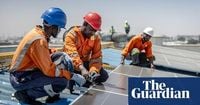Deep in South Africa's Northern Cape province, a single tower gleams above a field of solar mirrors, capturing sunlight and transforming it into enough electricity to power over 40,000 households for a full day. This is the KHI Solar One project—a symbol of both Africa’s untapped renewable energy potential and the continent’s urgent need for clean power. As world leaders, investors, and climate advocates gathered in Addis Ababa, Ethiopia, for the Second African Climate Summit on September 8, 2025, the spotlight was firmly fixed on Africa’s energy future and the global stakes riding on its success.
The numbers are stark: according to the International Energy Agency, some 600 million people—about 40% of Africa’s 1.5 billion residents—still live without electricity. In West Africa, the electrification rate plummets to just 8%, leaving 220 million people in the dark. The consequences ripple across society, limiting everything from children’s ability to study at night to hospitals’ capacity to provide lifesaving care. Economic growth, too, is stifled by unreliable or nonexistent power supplies.
Yet, as highlighted by a United Nations report released in July 2025, Africa is blessed with 60% of the world’s best solar resources. The continent’s deserts and warm climate make it a prime candidate for solar energy projects. Despite this, Africa has received just 2% of global clean energy investments in 2024, and only 1.5% of the world’s installed renewable power capacity is found on the continent. The gap between potential and reality is glaring, but recent developments suggest a turning tide.
At the heart of the Addis Ababa summit, President William Ruto of Kenya led a delegation determined to transform Africa’s climate challenges into economic opportunities. As chair of the Committee of African Heads of State and Government on Climate Change (CAHOSCC), Ruto’s leadership builds on the momentum of the inaugural African Climate Summit held in Nairobi in 2023. That historic meeting produced the Nairobi Declaration, positioning Africa as a hub for climate solutions rather than simply a victim of global warming.
“The Nairobi Declaration was our moment,” declared Ali Mohamed, Kenya’s special climate envoy, accompanying Ruto to Addis Ababa. “As we convene for ACS2, our charge is clear—to transform that 2023 ambition into action by scaling capital, unlocking value chains and forging alliances that anchor Africa’s competitiveness in the global green economy.”
Kenya, already a regional leader in geothermal, wind, and solar power, is banking on the summit’s continental goal: scaling renewable energy to 300 gigawatts by 2030, equivalent to the output of about 114 large power stations. This aligns perfectly with Kenya’s own energy expansion plans and could unlock billions in investment for projects ranging from green upgrades to the Standard Gauge Railway to massive solar installations in the country’s northern regions.
Dr. Fitsum Assefa, Ethiopia’s Minister of Planning and Development and National Coordinator of the summit, echoed the focus on “positioning Africa as the continent of homegrown solutions.” She emphasized that Africa, despite contributing less than 4% of global emissions, bears some of the harshest impacts of climate change. Prolonged droughts and severe flooding, all too familiar to Kenyan communities, underscore the need for urgent and innovative action.
But Africa’s strengths are equally clear. The continent boasts the world’s youngest population, vast renewable energy resources, and communities with a track record of climate innovation. As Mohamed Adow, Executive Director of Power Shift Africa, put it, “Africa has immense potential. This summit must resolve the paradox of lack in abundance—the most arable land, mineral resources, abundant renewable energy potential, and a vibrant and educated human capital.”
Outside the summit halls, the global investment community is taking notice. On September 8, 2025, Octopus Energy, a major UK-based renewable energy company, launched the Octopus Energy Power Africa Fund with an initial £60 million, aiming to mobilize £250 million over three years. The fund, developed in partnership with Pembani Remgro Infrastructure Managers, will invest across Sub-Saharan Africa in rooftop solar, battery storage, electric vehicle charging, and smart grid upgrades. Octopus’s previous partnerships include building Sierra Leone’s first wind farm and supporting MOPO, a solar battery company bringing power to off-grid communities.
“Africa is home to nearly 40% of the world’s renewable energy potential, but receives just 2% of global clean energy investment,” Octopus Energy stated. “We’re not just building big solar farms. We’re targeting the technologies that can transform how Africa powers itself at every level.” The company’s mission is clear: help Africa become a clean energy superpower, leveraging abundant sunshine, strong winds, and surging demand.
China, too, has ramped up its involvement. According to energy think tank Ember, Chinese exports of solar panels to Africa soared 60% in the past year, reaching 15,032 megawatts. Twenty African countries set records for solar panel imports, with shipments outside South Africa tripling in the last 12 months. This surge comes as independent energy companies increasingly see Africa as a market ripe for solar solutions, especially as countries like South Africa grapple with electricity crises and frequent blackouts.
At the Addis Ababa summit, Mukhtar Babayev, Special Representative of the President of Azerbaijan for Climate Issues and President of COP29, underscored the global stakes. “We are all well aware of the threat that the climate crisis poses to the world. We also know that African countries, despite contributing the least to global emissions, will be at the forefront of these challenges. The continent has the potential to become a global leader in the transition to zero emissions.”
Babayev highlighted the “Mission 300” initiative—Africa’s drive for 300 gigawatts of renewable energy capacity by 2030—and recalled Azerbaijan’s support during the Africa Energy Summit in Tanzania earlier this year. He pointed to recent financial commitments: at COP29, developed countries pledged $300 million annually by 2035 and set a new target to mobilize $1.3 trillion annually for developing nations. Babayev stressed, “The main issue now is the fulfillment of the commitments made. The COP29 Presidency will keep an eye on the implementation of every promise and continue cooperation with partners to make the global financial system work better for people and the planet.”
Despite these bold ambitions, the path ahead is not without obstacles. The June 2025 climate talks in Bonn, Germany, ended with some progress but left gaps in climate finance commitments. African leaders, including President Ruto, are pushing hard for the promised $1.3 trillion annually by 2030 from developed nations—a sum that could transform infrastructure and energy sectors across the continent.
The stakes could hardly be higher. Africa’s energy demand is projected to grow faster than anywhere else on Earth. The decisions made today—about how to power that growth—will shape the continent’s climate, economy, and global standing for generations. As the summit in Addis Ababa draws to a close, the world is watching to see whether Africa’s promise as a clean energy superpower can finally be realized, and whether the global community will step up to match ambition with action.



